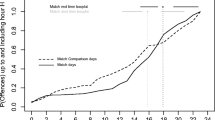Abstract
As a leading global reinsurer, Swiss Re deals with many hazards and risks for which geospatial data are crucial in order to obtain reliable assessments of expected insured losses or large losses from catastrophes. Typically, such data are used in combination with insurance data either in pricing tools to calculate premiums, tail risks and more, or in mapping tools. In natural perils pricing applications—the most important group of tools—geospatial data are usually “not visible” but are instead used to create probabilistic event sets. For example, a flood event set may define spatially if and how frequently a given location is flooded. Mapping tools, such as Swiss Re’s CatNet® (www.swissre.com/catnet), visualize the data in the form of maps which include many useful attributes per geographic location.
Similar content being viewed by others
Author information
Authors and Affiliations
Corresponding author
Rights and permissions
About this article
Cite this article
Hausmann, P. Geospatial data: a key ingredient for Swiss Re’s underwriting and service tools. Nat Hazards 86 (Suppl 1), 197–198 (2017). https://doi.org/10.1007/s11069-016-2642-0
Received:
Accepted:
Published:
Issue Date:
DOI: https://doi.org/10.1007/s11069-016-2642-0




